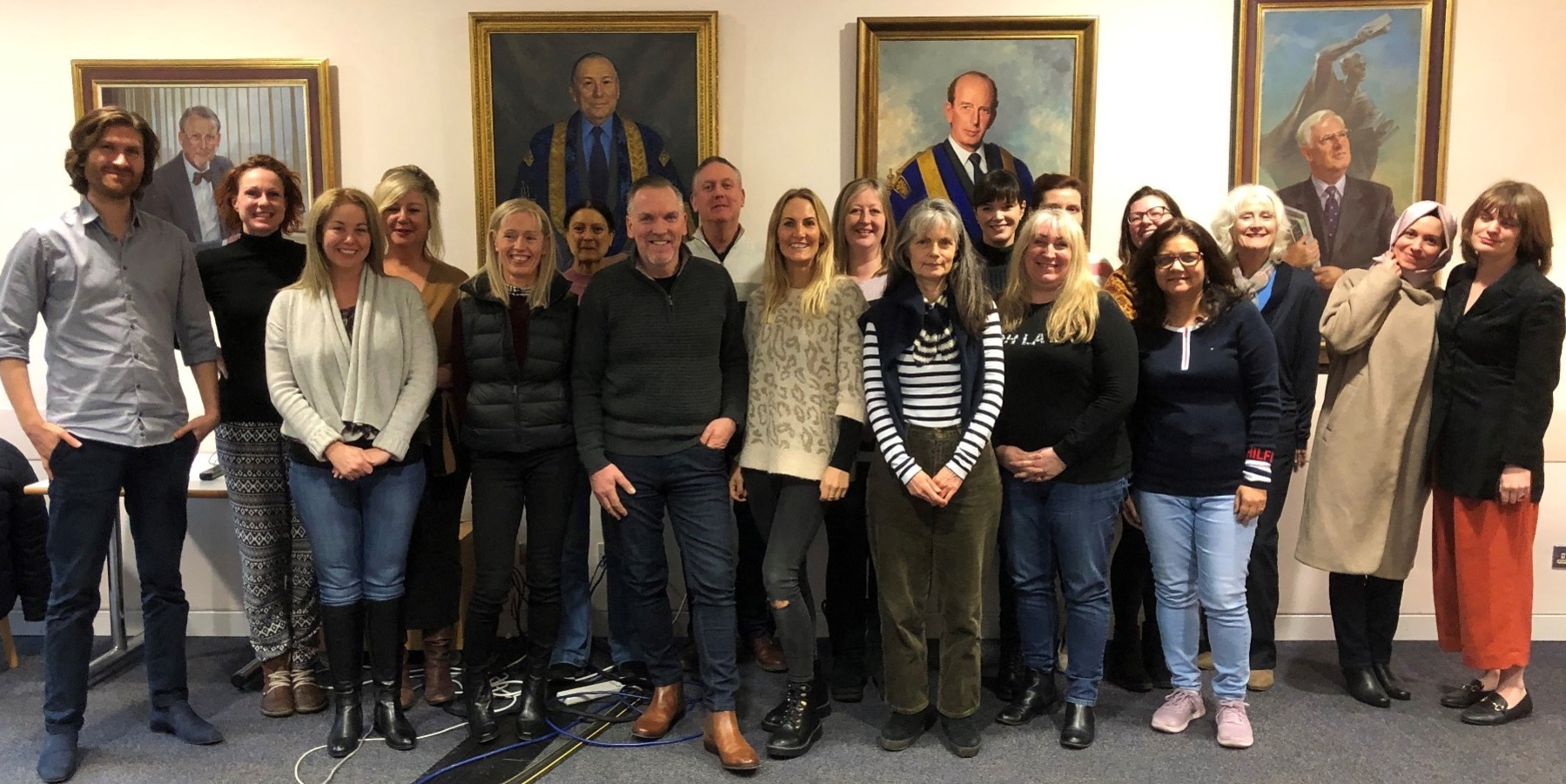INTRODUCTION TO HYPNOTHERAPY WEEKEND EMDR Plus Weekends Eye Movement Desensitisation Reprocessing Plus EMDR Plus
April 27th & 28th & May 18th & 19th 2024
EMDR Plus
Course Fee £235 per weekend
EMDR at a glance EMDR, developed by Francine Shapiro, circa 1986. Initially developed to address Post Traumatic Stress Disorder, PTSD.
Whist using EMDR, therapists quickly realised the client's brain was processing information naturally and at a faster rate; this is now known as Accelerated Information Processing, AIP.
Shapiro realised, by moving the eyes in a prescribed manor whilst considering a troubling event, the brain would process the feelings related to the event to a resolution, allowing the client to move on and in the case of PTSD, the client would no longer be traumatised by the event.
We have come to understand that our eyes do not move randomly, the positioning of the eyes demonstrates the part of the brain being accessed, which can facilitate the emotions experienced by the client.
The PTSD experience, is currently believed to be the client's brain attempting to process information to a resolution, but unable to do so due to missing sensory information experienced during the trauma.
By stimulating the hemispheres of the brain through eye movement and the EMDR process, the brain will blend the missing sensory information into a cohesive sensory narrative, allowing the trauma to be processed to a resolution.
The brain having worked the issue through allows the client to come to terms with the traumatic incident, and move on.
Eye Movement Desensitisation Reprocessing
EMDR is a therapeutic technique which is compatible with several other brief strategic interventions. These interventions can be combined, creating EMDR Plus.
EMDR HISTORY
Francine Shapiro, noticed that certain eye movements reduced the intensity of disturbing thoughts.
She then conducted a scientific study with trauma victims in 1988 and the research was published in the Journal of Traumatic Stress in 1989. Shapiro noted that, when she was experiencing a disturbing thought, her eyes were involuntarily moving rapidly. When she brought her eye movements under voluntary control while thinking of a traumatic thought, anxiety was reduced.
Shapiro developed EMDR therapy for post-traumatic stress disorder, PTSD. She speculated that traumatic events "upset the excitatory/inhibitory balance in the brain, causing a pathological change in the neural elements".
EMDR therapy uses a structured, phased approach to address the past, present, and future aspects of a traumatic or distressing memories.
The therapy process and procedures are guided by the Adaptive Information Processing model.
EMDR DEVELOPMENT
Increasingly, EMDR therapy is being used for the treatment of other issues including:
Depression
Performance anxiety
Phobias and fears
Anxiety
Low self-esteem.
Reported benefits of EMDR include:
A reduction in re-experiencing trauma memories.
Feeling more able to cope with and manage trauma memories without needing to avoid potential triggers.
Feeling more able to engage in and enjoy pleasurable activities and relationships.
Reduced feelings of stress, anxiety, irritation and hyper-vigilance - allowing the client to rest well, address pressure and/or conflict and go about daily business without feeling fearful and prone to panic.
Reduced feelings of isolation, hopelessness and depression.
A boost in self-confidence and self-esteem.
Accelerated Information Processing AIP
Apparently our eyes do not move randomly, our eyes move in conjunction with the part of the brain being accessed at the time. This phenomena can be observed in everyday conversation.
EMDR theory suggests, reoccurring anxiety develops when our brain is unable to process a thought or event, the hormonal change that accompanies stress, blocks our brain from processing an issue through to a resolution.
EMDR theory suggests, we can help the brain to process information relatively quickly and thoroughly to lasting change by eye movements.
This process is known as AIP, allowing a qualified therapist to use the EMDR protocol, to help a client process information through to a resolution for lasting change.
IS EMDR Hypnotherapy?
EMDR is not considered to be formal hypnosis, however the client will access an altered state of awareness, hypnosis, similar to a day dream, which is considered to be clinical hypnosis.
This clinical hypnotic state is relatively easily induced and deepened if required.
The client remains fully aware at all times during the EMDR session, maintaining total control over what is happening.
If required the therapist and client can work content free, allowing anonymity for the client.
It is usual for the therapist to address the clients self esteem before the end of the session, after all we can all benefit from feeling better about ourselves.
Francine Shapiro

EMDR Plus
EMDR takes an innovative highly effective approach to change, which can be content free.
By adding compatible therapeutic interventions such as, Emotional Freedom Technique, EFT, Neuro Linguistic Programming, NLP, Rapid Cognitive therapy, RCT and a pinch of magic, the SCCP have developed EMDR Plus, a unique approach to change.
To learn more about:
EFT at a glance
Why is Everyone Talking about EFT?
EFT is a direct descendant of Thought Field Therapy (TFT), a complicated meridian energy procedure, where each part of the body had a specific meridian line to tap, developed in the 1980s by Psychologist, Dr Roger Callahan.
A student of Callahan's, Stanford graduate engineer with an interest in psychology and NLP Gary Craig, introduced EFT in 1995 as a simplified adaption of TFT.
It is believed that the feelings in the body are regulated by energy flow. When there is a blockage or build up of energy we experience feelings, such as a tight chest when experiencing anxiety. By tapping on certain meridian points the energy is released to flow and the feelings ameliorate, now that the feelings are no longer driving a thought pattern of, "I am anxious when -" the cognition can change rapidly and completely.
Roger Callahan

Gary Craig

We would be offering EFT an injustice to discuss the subject in a few sentences.
EFT has evolved into many useful adaptions over the years and can now be found in many forms.
Gary originally meant this to be an energy therapy, similar to acupuncture, however EFT has become much more effective when used with other therapies such as EMDR, CBT and NLP if not psychotherapy in general.
In the correct hands, EFT is a powerful tool and dramatic results can be experienced however, just tapping on certain points of the body has its limitations, having an understanding of people and psychotherapy can dynamically enhance results and so braids nicely into the SCCP hypnotherapy experience. To Learn More
The Syllabus Includes:
The Background of EFT
The Discovery Statement
The Full Basic Recipe
Psychological Reversal
The Short Cut Version Aspects
SUDS
Getting Specific
Personal Peace Procedure
Borrowing Benefits Association/Dissociation
EFT for Addictive Cravings EFT for Pain/Physical Discomfort
Developing questioning skills
More Creative Ways to Use EFT
The Trauma Techniques:
Telling the Story;
Movie Technique;
Tearless Trauma
Working with an Unpleasant Memory
Gentleness through Dissociation
Phobias
Physical Issues & Chasing the Pain
Constricted Breathing Technique
Finding Core Issues, Specific Events & Aspects
Asking Key Questions
Advanced Psychological Reversal
Testing your Results
Limiting Beliefs & The Palace of Possibilities
Group work & Borrowing Benefits
An Introduction to Surrogate Tapping
An Introduction to Working with Children & Animals
EFT by Telephone & Skype
Reminder of Safety for Self & Client
The history and development of EMDR.
AIP, the process
Clinical observations
The memory system
Activating the information processing system
EMDR the treatment outline.
Helping the client to access positive and negative cognition.
The clients first therapeutic appointment.
The clients second therapeutic appointment
Phobia protocol
Processing habits and behaviours
The EMDR approaches will be discussed in detail.
The EMDR technique will be demonstrated, with the view to working with the client.
Supervised EMDR practise.
Integrating: EFT, NLP, and RCT to form EMDR Plus
This is an integral weekend in the SCCP Advanced Hypnotherapy Diploma.





